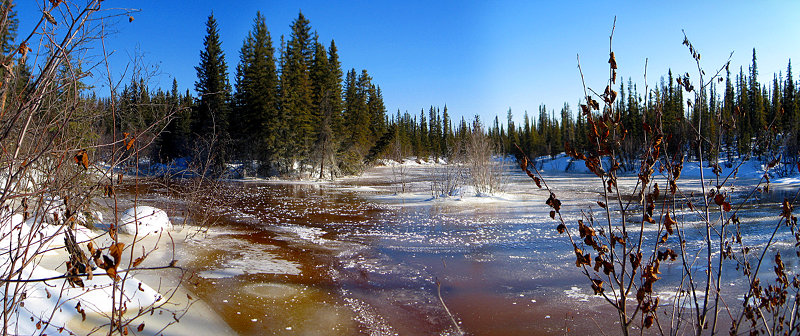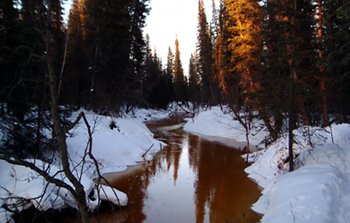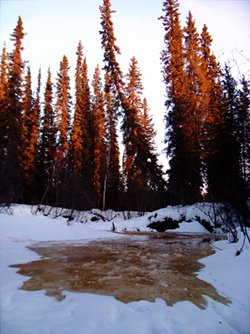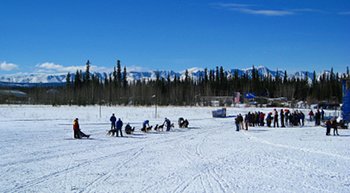
Fermentation, day one
Yesterday I brewed my ninth batch of Piper’s Irish-American Red Ale, based on a recipe from Jeff Renner posted in the Homebrew Digest. It’s an easy drinking, low alcohol (4.0—4.7%) red ale. My version isn’t a traditional Irish Red Ale because it’s got six-row malt and corn in it, but this is likely to have been the combination of grains used by early Irish immigrants to the United States. When the English first colonized North America, two-row barley for brewing was imported from Britain. Six-row barley grew much better in our climate, but it is higher in protein than two-row barley, which results in a cloudy beer, and one which spoils more readily (especially without refrigeration). The solution to this problem is to replace some of the six-row barley starches with other types of starch like corn. The high-protein barley will readily convert the starches in the corn to the simple sugars that yeast can consume, and the total amount of protein in the final product will be reduced. It was a great adaptation to the native strain of barley grown in early America.
We don’t have to worry about that now, of course, but I enjoy renewing some older brewing traditions. This batch is a little over 40% British two-row pale malt, 30% American six-row malted barley, and 20% flaked maize. There’s some flaked barley for head retention, and crystal 60 and chocolate malt to produce the malt flavor and color of a red ale.
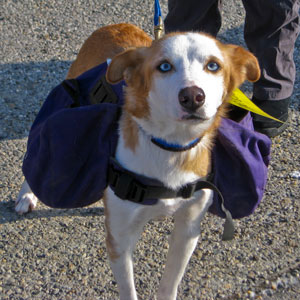
Andrea’s photo of Piper, The Toothbrush Dog
I was trying out a new transfer pump on this batch, as my previous one was damaged by ice the last time I brewed. I’d left my water supply barrel outside overnight and when the very cold water hit the pump, it froze. The other issue with the old pump was that it would shut down when the outlet flow was constricted too much, a problem during chilling because I use a ball valve to limit the flow of cold water into the plate chiller. The new pump screamed right through the constricted flow and I got the wort from boiling to 64°F without any problems this time. I would have preferred a pitching temperature closer to 68°F, but I’d made a yeast starter, and the low wort temperature didn’t seem to slow it down at all. This morning there was a thick head of yeasty foam on the surface (as you can see in the photo).
While I was brewing, Andrea took some of the dogs to Mush for Kids where Piper was the Toothbrush Dog. She walked around with a backpack filled with toothbrushes for the kids who went to the event. Check out Andrea’s blog for more details and photos.
Curious to find out how far up the overflow went, I rode my bike on the mushing trail upstream to Larry’s pond. It’s a quarter-mile bicycle ride, but is more like half a mile upstream from our house as the fish swim. As you can see from the panorama above, the overflow is upstream of this point. My foot broke through the ice while I was taking this photo and it was about 8 inches deep at the edge of the pond. The Creek is connected to the pond on the left side of the photo. If the blog sidebar is cutting into the photo, you may need to make your browser window wider. Click on the image for a very large (1400 pixels wide) version.
The photo was stitched together with the Hugin front end to panorama tools. The exposure of the right-most frame isn’t perfect, but that’s where the sun was, so I think it did an amazing job.
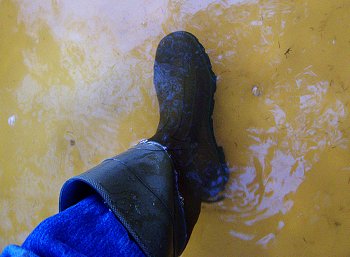
Water over ice
Yesterday afternoon while I was brewing beer (more on that later), I took Nika out for our usual walk. We go across the bridge, walk along the north side of the Creek until we get to the confluence of the Creek and the Slough (the “stick throwing spot”), then drop down onto the Creek and walk back. Typically we’ll walk under the bridge and come back up onto land near the red cabin. Yesterday we kept going another few hundred feet until we came across some overflow. It was only a few inches deep and didn’t seem to be advancing.
Last year we got some overflow early in the winter, but by January it seemed to have stopped and we didn’t get anymore until the Creek broke up at the end of April. This year it’s been lightly overflowing in spots around our house pretty much all winter. With all the late season snow, it’s been a good thing because it keeps the depth of the snow on the Creek lower than it would be. I did use snowshoes a couple times because the snow had gotten deep enough that it wasn’t fun to wade through, and Nika had a hard time swimming through it.
In the evening, I got up to get myself a Silver Gulch Hefeweizen, and was surprised to see running water over the whole length of the Creek. I went outside to investigate and take some photos. The water flowing over the ice was about 10 inches deep (you can see it in the photo of my boot on the right). The photo on the left (assuming you’re reading this on my blog and not in an aggregator…) shows what it looked like when I initially got out there.
I walked downstream through the overflow and came to the end of it near the stick throwing spot. It was pretty wild walking through almost a foot of water on top of the ice, and as I neared the bend at the slough, it started getting shallower and shallower. Eventually, I walked up onto the snow and took a few photos as the water advanced.
This morning the water level on top of the ice is up to 14 inches. The low temperature last night was -14°F (and it’s still -10°F as I type this), so the margins of the overflow are already frozen to around ½ an inch, and there’s steam rising from the flowing center. It’s great to hear flowing water again, but that much water suddenly appearing does make me a little nervous. We’re not in any present danger as the low point in the dog yard is easily three feet higher than the current level of the slough, but when a foot of water can suddenly appear over the frozen ice, who knows?
The top of the slough now has some water in it too, but I haven’t walked out on the trail to see how far the water has advanced. Depending on how much more water there is and the average temperature for the upcoming weeks, it looks like our walks on the Creek might be over for this winter. I’m curious to see how all the water will affect the breakup date this year. The weather service is predicting lows in the 20s and highs near 40 all week in Fairbanks, but that probably means lows near zero and highs barely above freezing here in the Valley, so breakup probably isn’t happening this week.
The 2009 Tok Race of Champions is over. It didn’t get very cold on Saturday night, so the trail didn’t get a chance to set up after the first day of racing; it was slow and had a lot of soft spots that teams had trouble getting through. Andrea held onto 15th place in the six dog class (earning a whopping $12.50), and Bonnie got 13th place. This year the eight dog course took them along the road for more than three miles so we got a chance to see Bonnie running with her team for awhile. It was cool to see her dogs running next to us, especially since I mostly see them before and after the races.
I don’t know how easily it’ll be to view this, but the following link is a video of her coming out near the road: video of Bonnie.
It was a fun race this year, and we’re at home recovering with the dogs today.
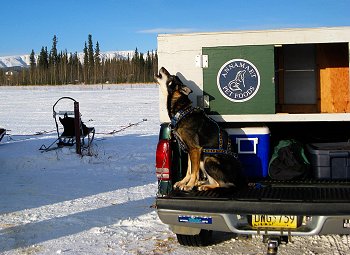
The first day’s racing is over and all the dogs are happy and healthy. There isn’t a four-dog class in Tok, so Andrea borrowed Rubus and Vive from Bonnie to make up a six-dog team. Buddy ran lead with Rubus, Koidern and Piper ran in swing, and Kiva and Vive where at the back of the team. It was 14°F when the first team went out, so the sun hadn’t started warming things up. Andrea went around the track in 18 minutes 39 seconds, which was good enough for 15th out of 25.
Bonnie raced in the eight-dog class, but the results of the first day were thrown out because the first musher on the trail went through a fence, and a series of other mushers failed to make the proper turn with the fence missing. It’s somewhat of an unprecedented move to invalidate the first day of racing.
The photo is of Kiva howling before the race.
